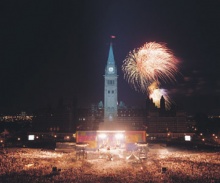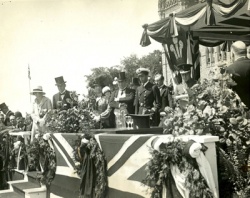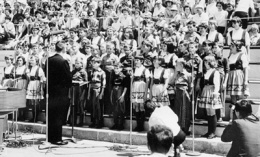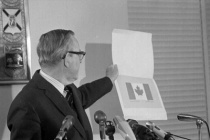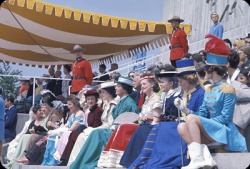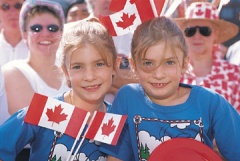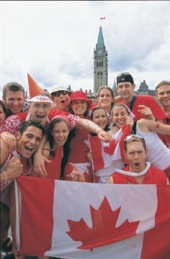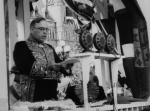Canada Day
par Hayday, Matthew
Celebrated on the first of July, Canada Day (or Dominion Day as it was officially known until 1982) commemorates the Canadian Confederation of 1867. In 1958, the federal government of John Diefenbaker began the tradition of hosting official celebrations in Ottawa, combining both formal and festive components, to commemorate the founding date of the country. The nature of the celebrations held in the National Capital Region have changed over time to reflect changing conceptions of Canada's national identity. Grouping together performers from across the country, these celebrations, taken together, present an evolving conception of the linguistic and cultural heritage of Canada.
Article disponible en français : Fête du Canada
Creating a tradition of celebration
On 1 July 1867, the federal union of Canada officially came into being. To celebrate, a nation-wide holiday of Dominion Day was proclaimed, which was celebrated in communities across the country with picnics, parades, sports, bonfires and firework displays. For most of the first century of Canada's existence, the anniversary date of the founding of the country was celebrated in local communities, however, Canada's federal government did not organize any celebrations in an official capacity. The notable exception to this rule was the Diamond Jubillee Celebration of 1927 which observed the 60th anniversary of Confederation on Parliament Hill, and included a coast-to-coast radio broadcast of patriotic music and radio pageants. (Events had been planned for the 50th anniversary of Confederation, but were cancelled because of the First World War.) In the years immediately following the Second World War, significant public activities were organized by the French-Canadian community in Ottawa to celebrate June 24th, the Feast Day of John the Baptist, the patron saint of French Canada (la Fête de la Saint-Jean-Baptiste). Yet the federal government did nothing to celebrate Dominion Day. Indeed, the federal Parliament routinely conducted business on July 1st, and the Liberal government of Louis St-Laurent resisted calls from the Conservative opposition to recess Parliament for Dominion Day events.
The decision to organize federally-sponsored Dominion Day celebrations originated with Prime Minister John Diefenbaker, who was concerned by what he viewed as an erosion of Canada's British heritage. In his view, this erosion was evident both in the unwillingness of Louis St. Laurent’s Liberal government to defend Britain's actions during the Suez crisis of 1956, and in this same government's elimination of the term "Dominion" from federal institutions as part of an effort to reinforce a model of Canadian identity which was less overtly tied to Britain and more inclusive of francophones. The first of what became an annual celebration of Dominion Day on Parliament Hill organized by the Secretary of State of John Diefenbaker, Ellen Fairclough, in 1958. Diefenbaker envisaged these celebrations as a means of celebrating Canada's British heritage, and they thus featured a combination of military pageantry, speeches from the Governor General and top government officials and a carillon concert. The only token nods to Canada's French-Canadian heritage were the inclusion of a few French-Canadian compositions in the carillon concert and selections played by the military bands. The program distributed to guests was also bilingual.
Beginning in the early 1960s, the Department of Citizenship and Immigration worked together with the Secretary of State Department to plan Dominion Day programming. Officials with the department believed that adding a dance and folk music component to the program would popularize the event, particularly among recent immigrants to Canada. With this in mind, the Dominion Day events on Parliament Hill began to include performances from popular and amateur Canadian performers. Beginning in 1960, CBC and Radio-Canada televised at least part of these events. From 1961 to 1964, les Feux-Follets, a folk dance troupe from Montreal, were selected to represent French-Canadian culture. Each year, they performed several dances, including at least one traditional French-Canadian dance, and a selection of folk dances from other countries.
Bilingualism and Biculturalism at Canada's Centenary
In 1963, responding to calls from Le Devoir editor André Laurendeau, the newly-elected Liberal government of Lester B. Pearson created the Royal Commission on Bilingualism and Biculturalism. One of the hallmarks of the Pearson’s government would be its efforts to refashion official conceptions of Canadian identity to make it more inclusive of French Canada and less tied to older British-centric models. The most obvious manifestation of this policy was the adoption of the maple leaf flag as Canada’s official flag, replacing the British Union Jack and the Red Ensign (which featured the Union Jack in miniature). This change was initially resisted in English-speaking Canada, although a majority eventually rallied behind the new flag, with the notable exception of Conservative party leader John Diefenbaker, who fought fiercely in Parliament against the new design.
Pearson's government was responsible for organizing the Centenary celebrations of 1967. As part of its efforts to increase Canadian enthusiasm for the centennial year, the federal government increased funding to the Dominion Day celebrations in Ottawa, which made it possible for the organizers to bring in performers from across the country, rather than only local performers from Ontario and Quebec as had been the case prior to 1964. In its selection of performers, the federal government placed its emphasis on the three first groups to establish themselves in Canada – "à savoir les Amérindiens, les Français et les Britanniques" .
As a result of this increased funding, it became possible for the televised CBC/Radio-Canada broadcasts to project a broader image of Canada's French-Canadian heritage. Among the performers in the 1960s were numerous Acadian performers, including Edith Butler, an Acadian choir directed by Mère Ste-Thérèse-du-Carmel, and Les chanteurs du Mascaret. The French-Canadian presence in Western Canada was also well-represented. In 1966, one of the hosts was Miss Canada Diane Landry, a bilingual franco-Manitoban who sang about her coureur-des-bois ancestor Jean-Baptiste Lagimonière. The same year, Geoff Howard from Saskatchewan performed his own composition about Métis leader Louis Riel. Quebec itself was also well-represented by numerous amateur youth dance troupes and choirs.
National Unity through Festivity
In the years following the centennial, annual Dominion Day events continued to be organized in Ottawa, but on a smaller scale and not always in a televised format. This continued until 1975, but the 1976 celebrations were cancelled due to budget cuts. At the same time as the Ottawa celebrations were winding down, the Quebec government was injecting new funds and energy into the St-Jean-Baptiste Day celebrations, which were renamed the "Fête nationale du Québec". Celebrations organized for Montreal, in particular, drew crowds in excess of one million to Mount Royal for the week-long festivities. The November 1976 election of the Parti Québécois government, which was committed to holding a referendum on sovereignty-association, shocked the federal government, which resolved to make a more concerted effort to promote national unity.
The July 1st celebrations – referred to as Canada's Birthday Celebrations, rather than "Dominion Day", which was less popular in Quebec – were part of the federal government's unity strategy. Over $3 million was allocated to the 1977 celebrations, with slightly less for 1978 and 1979. High-profile performers were sought to participate in a nation-wide broadcast that linked together stages across the country via satellite. The three-hour broadcast was simulcast on 842 of the 844 radio and television stations in the country.
Conceived as a national unity project, the July 1st events had their greatest difficulties incorporating French Canada. While disco singer Patsy Gallant, an Acadian, was featured prominently, as was Moncton-based singer Calixte Duguay, it proved very difficult for the organizers to obtain high-profile Québécois performers. Many followed the edict of the Union des artistes du Québec, which expressed its disapproval of any performer who agreed to work for the federal government. Others had overtly separatist sympathies and chose, like Robert Charlebois and Diane Dufresne, to perform instead at Quebec's Fête Nationale events. Those who did choose to perform, the most prominent of which were Ginette Reno and René Simard, were criticized in the Montreal press for being sell-outs, with columnists bitterly observing that they made most of their money in the United States anyways. While these events attracted a wide Canadian audience (over 11.7 million Canadians watched part of the 1977 broadcasts), the polling and media response from Quebec did not indicate that these events were a spectacular success in that province.
Depoliticizing Celebration
After the defeat of the 1980 referendum, the federal government again reduced its emphasis on the Ottawa-based July 1st celebrations. The official name for the day was changed in 1982 to Canada Day, the result of a private member's bill sponsored by Hal Herbert, Member of Parliament for Vaudreuil, Quebec. Community-based celebrations received funding from the federal government, and small-scale events were organized on Parliament Hill, although they were not televised. The large-scale Ottawa events were revived in 1988, and have continued to the present day. The Canada Day events are normally centered around two major celebrations. A noon-day event features speeches by the Governor General and Prime Minister, and usually includes some high-profile dance or musical performances. The evening events are intended to create a party or rock concert atmosphere, and feature high profile and up-and-coming artists from across the country.
While the emphasis in the selection process has been on attracting high-profile performers who will appeal to both the live and the television audiences, organizers have been careful to ensure a regional, ethnic and linguistic balance in their selection of performers. It is also possible to detect a deliberate attempt to ensure that the francophone artists are selected from across the country, and are not limited to Quebec-based performers. Thus, in addition to Québécois artists including Céline Dion, Nanette Workman, Diane Tell, Isabelle Boulay, Les Cowboys Fringants, Luck Mervil and Lara Fabian, there has been a diverse array of performers representing Acadian and French-Canadian communities across the country, ranging from Saskatchewan country-rock singers Hart Rouge to New Brunswick pop singer Patsy Gallant to the Franco-Ontarian jazz group Swing. Acadian singers in particular have played central roles in these celebrations. The 1992 performances of "I'll Always Be There" by Roch Voisine, accompanied by producer David Foster, served to launch the bilingual singer's career in English Canada. Voisine also performed a number of his French-language hits, including the international smash "Hélène". In 2005, the 250th anniversary of the Acadian expulsion, Star Académie winner Wilfrid LeBouthilier headlined a noon-day show featuring a host of Acadian artists.
Taken together, the Canada Day celebrations on Parliament Hill have been an important means for the Canadian federal government to celebrate and promote Canadian culture and identity. These events have been a showcase for rising Canadian talent from across the country. In relation to French Canada, they have also provided the federal government the opportunity to present a vision of French Canada which is not limited to the province of Quebec, and to project this across the country with the assistance of the CBC and Radio-Canada. In this manner, the federal government is able to use these festivities to reinforce its cultural and identity policies. In recent years, these celebrations have grown in size, and have become a major tourist draw for the National Capital Region. The atmosphere which pervades the streets of Ottawa is both celebratory and patriotic – it is not uncommon to have groups of revelers burst into a chorus of “O Canada!” In this respect, Canada Day celebrations in Ottawa-Gatineau have also become an occasion and venue for Canadians to give voice to patriotic sentiments not normally expressed during the rest of the year. Thus, while the format and message of Canada Day celebrations have changed since they were first held in 1958, this “invented tradition” has taken on a life of its own as a major Canadian cultural celebration.
Matthew Hayday
University of Guelph
NOTES
1. LAC, RG 6 Secretary of State, Acc. 1986-87/419, Box 15, File 1-7-4/1-1 pt. 1964: National Celebrations – Dominion Day – Parliament Hill – 1964. Memo from Jean Lagassé to Minister, 2 July 1964.
BIBLIOGRAPHY
Beauchemin, Annie, «Des sondages historiques, des sondages publics: Le Dominion Insitute, la Fête du Canada et le Jour du Souvenir», Bulletin d’Histoire Politique, no.14, automne 2005, pp. 263-277.
Buckner, Phillip (Dir.), Canada an End of Empire, Vancouver, UBC Press, 2005, 328 p.
Creighton, Donald, The Road to Confederation: The Emergence of Canada 1865-1867, Toronto, MacMillan, 1964, 489 p.
Cupido, Robert, «Appropriating the Past: Pageants, Politics, and the Diamond Jubilee of Confederation», Journal of the Canadian Historical Association, no.9, 1998, pp.155-186.
Cupido, Robert, «The Medium, the Message and the Modern: The Jubilee Broadcast of 1927», International Journal of Canadian Studies, no.26, Fall 2002, pp.101-123.
Davies, Helen, «The Politics of Participation: A Study of Canada’s Centennial Celebration», PhD Thesis, University of Manitoba, 1999.
Hobsbawm, Eric and Terence Ranger (Dir.), The Invention of Tradition, Cambridge, Cambridge University Press, 1983, 320 p.
Igartua, José, The Other Quiet Revolution: National Identities in English Canada, 1945-71, Vancouver, UBC Press, 2006, 277 p.
Mackey, Eva, The House of Difference: Cultural Politics and National Identity in Canada, London, Routledge, 1999, 199 p.
Malausséna, Katia. « Commémoration et lien territorial. L’Angleterre et le Québec en comparaison », Recherches sociographiques, no.43, 2002, pp. 79-110.
Miedema, Gary, For Canada’s Sake: Public Religion, Centennial Celebrations, and the Re-making of Canada in the 1960s, Montreal & Kingston, McGill-Queen's University Press, 2005, 308 p.
Additional DocumentsSome documents require an additional plugin to be consulted
Images
-
 (Jubilee Celebrations
(Jubilee Celebrations
) On Parliament... -
 (Jubilee Celebrations
(Jubilee Celebrations
) On Parliament... -
 (Jubilee Celebrations
(Jubilee Celebrations
) On Parliament... -
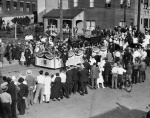 Confederation Jubilee
Confederation Jubilee
- The Historic...
-
 Diamond Jubilee of Co
Diamond Jubilee of Co
nfederation, Sa... -
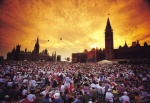 Foule, coucher de sol
Foule, coucher de sol
eil -
 La fête du dominion
La fête du dominion
-
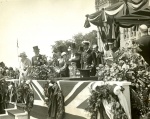 Le prince de Galles
Le prince de Galles
-
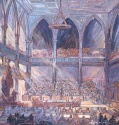 Réunion du premier pa
Réunion du premier pa
rlement de la C... -
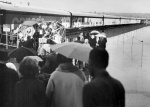 Train de la Confédéra
Train de la Confédéra
tion à Vancouve... -
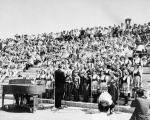 Various ethnic groups
Various ethnic groups
from many area...
Vidéo
Documents sonores
-
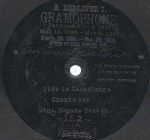 Ô Canada terre de nos aïeux
Interpreter : Joseph Saucier.
Writer : Calixa Lavallée et Adolphe-Basile Routhier.
Album : Columbia E2366-A (série ethnic), 1907.
Source : Bibliothèque et Archives Canada/O Canada, terre de nos aïeux/AMICUS 31422389.
Ô Canada terre de nos aïeux
Interpreter : Joseph Saucier.
Writer : Calixa Lavallée et Adolphe-Basile Routhier.
Album : Columbia E2366-A (série ethnic), 1907.
Source : Bibliothèque et Archives Canada/O Canada, terre de nos aïeux/AMICUS 31422389.
-
 Ô Canada, mon pays, mes amours
Interpreter : Paul Dufault.
Writer : Georges-Etienne Cartier et Jean-Baptiste Labelle.
Album : Edison 27132 (cylindre), 1913.
Source : Bibliothèque et Archives Canada/O Canada, mon pays, mes amours/AMICUS 33804566.
Ô Canada, mon pays, mes amours
Interpreter : Paul Dufault.
Writer : Georges-Etienne Cartier et Jean-Baptiste Labelle.
Album : Edison 27132 (cylindre), 1913.
Source : Bibliothèque et Archives Canada/O Canada, mon pays, mes amours/AMICUS 33804566.

